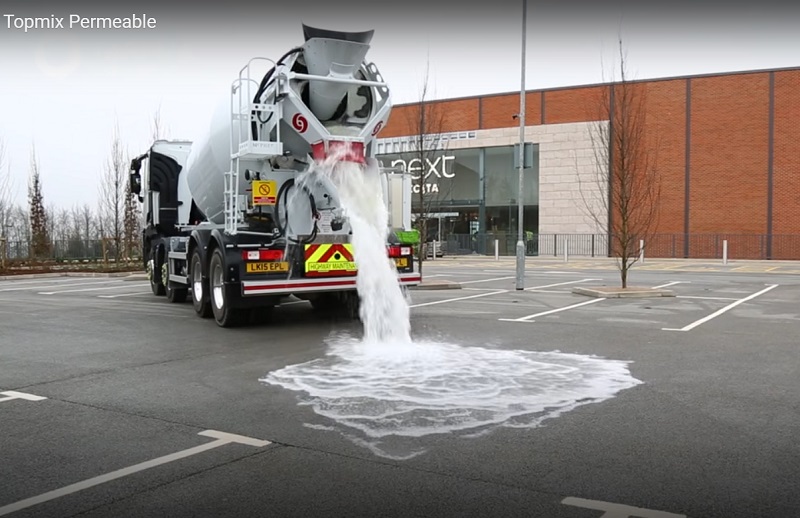Topmix Permeable
Contents |
[edit] Introduction
Topmix Permeable is a fast-draining concrete pavement solution that has been described as ‘thirsty concrete’ because of the rate it is able to absorb surface water.
Traditional concrete must be permeable enough to allow water through to ground level at a minimum rate of 300 mm/hour. By contrast, Topmix Permeable is capable of letting through around 36,000 mm of water/hour.
This innovative new material system, manufactured by Tarmac, offers much potential for the design of sustainable urban drainage systems (SuDS), in terms of being able to provide a practical answer to the perennial problems of surface water flooding.
Whereas conventional concrete is sand-based, Tarmac uses tiny pieces of crushed granite packed together. Known as ‘no-fines concrete’, this has a high void content of 20-35%, and allows surface water to drain through and dissipate naturally. This helps reduce the risk of surface water flooding and watercourse contamination.
Topmix Permeable can be used for a wide range of practical applications, including:
- Low volume residential roads and car parks.
- Pavements, bike and pedestrian pathways.
- Patios.
- Tennis courts.
- Road shoulders.
- Swimming pool decks.
- Alleyways.
- Driveways.
- Greenhouse floors.
- Pavement edge drains and gutters.
- Sports facilities.
- Below permeable blocks for ground stabilisation.
Applications where Topmix Permeable is not suitable include:
- Heavy goods vehicle delivery routes for shops.
- Access to car park ticket barriers.
- Tight turning areas in industrial yards.
- Bus routes.
- Areas with heavy silt loads, such as recycling centres.
[edit] System options
When constructing a pervious paving solution, Topmix Permeable offers three best practice applications that can be employed.
[edit] System A – Full infiltration
All water permeates through the surface layer, through the lower pavement courses and into the sub-grade. This system does not discharge any water into traditional drainage systems, but some water may be retained within the pavement before permeating into the sub-grade.
[edit] System B – Partial infiltration
The underlying ground offers some level of permeability and infiltration is acceptable. Outlet pipes are installed within the sub-base layer to allow excess water that cannot penetrate into the existing ground to drain into watercourses, swales, sewers, and so on.
[edit] System C – Full attenuation
This system is typically used where water recycling is required, where water may be contaminated, or where the sub-grade is impermeable. An impermeable membrane is installed above the sub-grade and outlet pipes installed within the sub-base layer. Water can be captured and harvested for use-use in non-potable applications such as irrigation, toilet flushing, and so on.
[edit] Surface durability
[edit] Heavy traffic
Topmix Permeable is scuff-resistant and resistant to softening in hot weather; however, it is recommended that an impermeable surface is used in areas exposed to frequent tight turning circles and sections carrying particularly heavy traffic.
[edit] Freeze-thaw resistance
Water should not be left to settle within the surface structure by an effective permeable pavement system. In this eventuality however, the Topmix Permeable allows freezing water to expand in the voids, providing freeze-thaw resistance. As the system does not contain rebar, it is not at risk of water or chloride attack.
[edit] Surface skid resistance
The skid resistance of Topmix Permeable is comparable to low texture asphalt and concrete typically used in the construction of footpaths and car parks. Therefore, it is suited to low speed applications, typically of less than 30 mph. Additional design consideration us necessary in areas of higher slip risk, such as slopes or where heavy breaking may occur.
[edit] Advantages
There are several benefits offered by Topmix Permeable:
- Rapid water removal ensures more effective storm water management.
- Safer roads are created as there is less standing water and so a reduced risk of hydroplaning.
- There is a reduced risk of flash flooding.
- There is reduced impact on the natural water cycle.
- There are reduced storm water management costs.
- It is a low-maintenance surface.
- No planning permission is required in domestic applications such as driveways.
For more information, see Topmix Permeable.
Images and content courtesy of Tarmac.
[edit] Find out more
[edit] Related articles on Designing Buildings Wiki
Featured articles and news
Homes England creates largest housing-led site in the North
Successful, 34 hectare land acquisition with the residential allocation now completed.
Scottish apprenticeship training proposals
General support although better accountability and transparency is sought.
The history of building regulations
A story of belated action in response to crisis.
Moisture, fire safety and emerging trends in living walls
How wet is your wall?
Current policy explained and newly published consultation by the UK and Welsh Governments.
British architecture 1919–39. Book review.
Conservation of listed prefabs in Moseley.
Energy industry calls for urgent reform.
Heritage staff wellbeing at work survey.
A five minute introduction.
50th Golden anniversary ECA Edmundson apprentice award
Showcasing the very best electrotechnical and engineering services for half a century.
Welsh government consults on HRBs and reg changes
Seeking feedback on a new regulatory regime and a broad range of issues.
CIOB Client Guide (2nd edition) March 2025
Free download covering statutory dutyholder roles under the Building Safety Act and much more.
Minister quizzed, as responsibility transfers to MHCLG and BSR publishes new building control guidance.
UK environmental regulations reform 2025
Amid wider new approaches to ensure regulators and regulation support growth.
BSRIA Statutory Compliance Inspection Checklist
BG80/2025 now significantly updated to include requirements related to important changes in legislation.






























